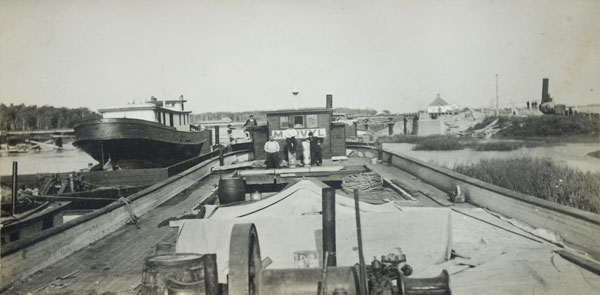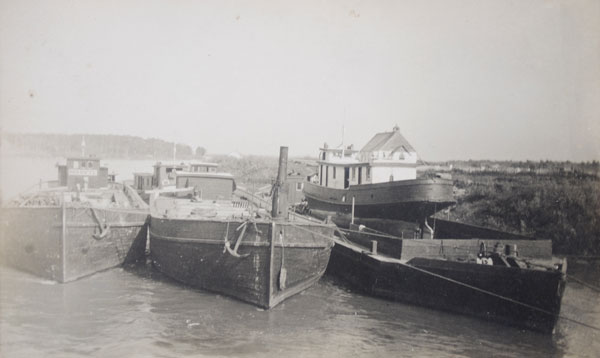Built in 1905, the Marvyl measured 120 feet stem to stern, had a beam 26 feet wide, draught of 8.5 feet, and displacement of 225 gross tons. The steamship operated on Lake Manitoba as a freighter and passenger ship for the Manitoba Gypsum Company (MGC) Limited. With the arrival of the Canadian Northern Railway to the MGC’s site at Gypsumville in 1910, its transportation role was largely obsoleted.
In 1911, this vessel along with four others (two towed barges along with the tugs J. R. Spear [hereafter Spear] and Victor) were identified by the company as having a total value of $50,000 and, owing to the railroad’s arrival, were now deemed surplus. Potential buyers at Selkirk were found who sought to use them along the Red River and on Lake Winnipeg, providing they could be removed from Lake Manitoba.
Captain Thomas Pollock, along with his associate Captain William Purvis, were engaged to survey and chart a possible route, settling on navigable path over 100 kilometers long via the Fairford River, Lake St. Martin, and Dauphin River. With the plan considered feasible, the ships were sold conditionally, and it was decided to make the attempt the following season. News of the planned expedition also garnered attention from the Federal Department of Public Works, who sought to transfer three of their own vessels (valued at $20,000); a tug along with two mud barges. With another contract sealed, Pollock’s flotilla now consisted on eight vessels.
For much of 1912, the Marvyl was used to transport lumber and tow lumber barges, during which time Pollock and his men worked to clear the charted channels of submerged obstacles and rocks. In August of that year, the Marvyl and the rest of the expanded fleet was brought south to Totogan. There, all possible spare equipment was removed and shipped by rail to Selkirk, where it was anticipated re-assembly would take place. The stripped-down hulls were then towed north to the Fairford River where Pollock and a crew would initiate the downstream transfer.
River conditions necessitated that the large vessels be affixed by cables to points along the river banks and slowly lowered downstream. Poor weather and other factors hampered progress, and it took two weeks for all boats to reach the Fairford Railway Bridge, of which the substructure was under construction. One span of the bridges temporary wooden deck spans was required to allow the passage of the larger hulls. While at the bridge, the Spear was loaded onto one of the barges, and the Victor was used to tow the rest to the channel area between the larger and smaller parts of Lake St. Martin. It was decided that the Victor and Spear-laden tug would continue down the Dauphin River, given their shallow draught. Marvyl and the remaining four ships were left in place. With the onset of winter, and the advance trio still some 16 kilometers from Lake Winnipeg, it was decided to bring them to a nearby creek and scuttle them to minimize ice damage during the winter and spring.
Efforts were renewed the following season and, as of July 1913, the furthest-along trio was still about a month’s worth of work away from reaching Lake Winnipeg, with Marvyl and the remainder anticipated to follow by the season’s end. When precisely she made it through to Lake Winnipeg is unknown, though ownership remained consistent for the next several years during the First World War. In 1921, Marvyl was sold to the Northern Fish Company Limited, and saw continued service until 1931, though later used as a barge. Subsequent ownership or fate is unknown.

The deck of the Marvyl, with J. R. Spear (left, loaded aboard a barge) south of the
Fairford Railway Bridge and St. Helen’s Anglican Church in the background (circa September 1912)
Source: Archives of Manitoba, Loudon G. Wilson fonds, PR1978-14, Photo #551.

Marvyl (left) on Dauphin River with Alexander (centre) and J. R. Spear (loaded atop another barge),
north of the Fairford Railway Bridge, with St. Helen’s Anglican Church in the background (circa September 1912)
Source: Archives of Manitoba, Loudon G. Wilson fonds, PR1978-14, Photo #543.
Period
Owner
1905-1919
Manitoba Gypsum Company Limited
1919-1921
?
1921-1931
Northern Fish Company Limited
“Remarkable feat of navigation,” Manitoba Free Press, 17 June 1913, page 4.
Selkirk’s 75th Anniversary. Selkirk: 75th Anniversary Committee, 1957.
Marvyl, The Nauticapedia Project.
We thank John MacFarlane (Nauticapedia) for providing additional information used here.
This page was prepared by Nathan Kramer.
Page revised: 12 February 2022